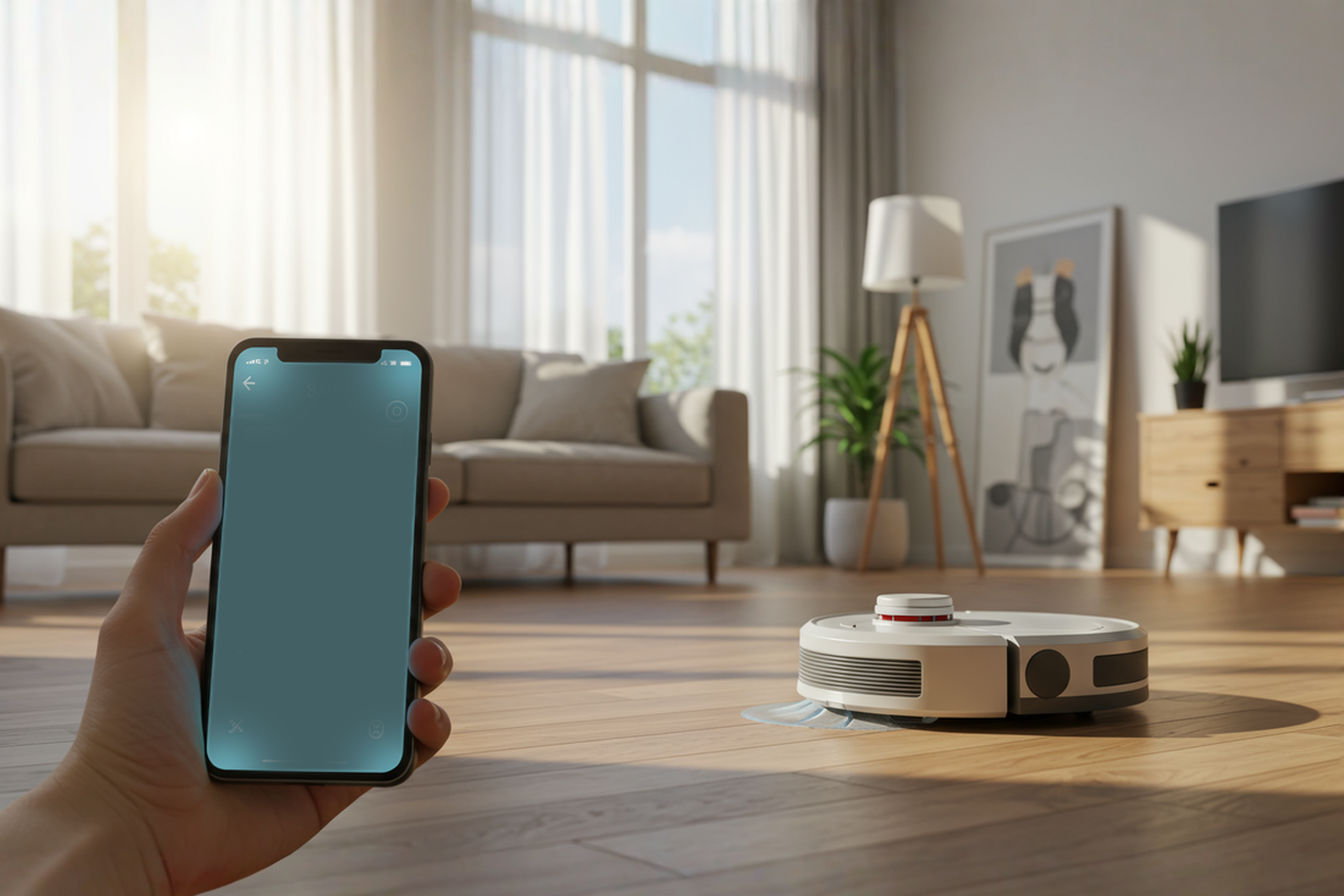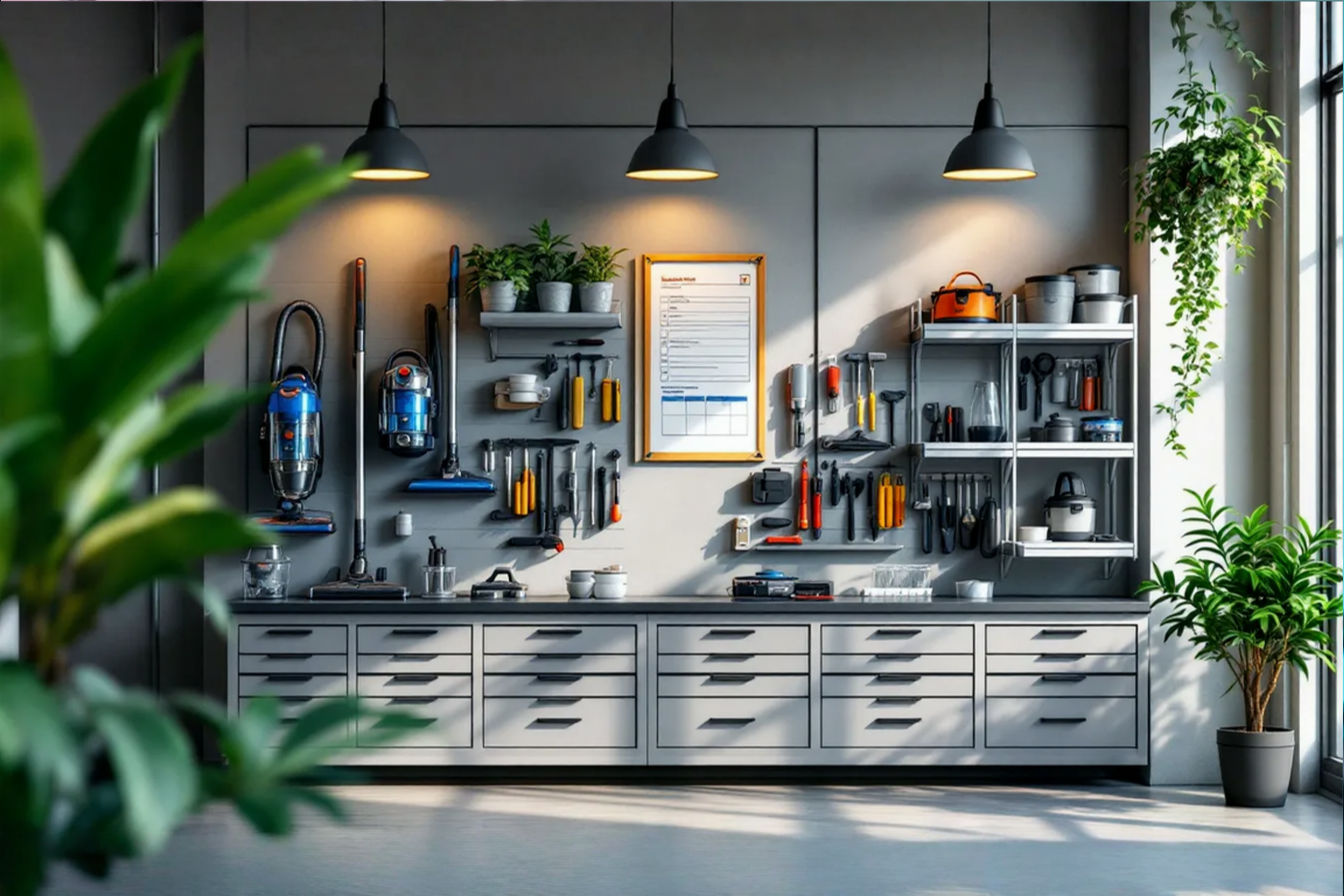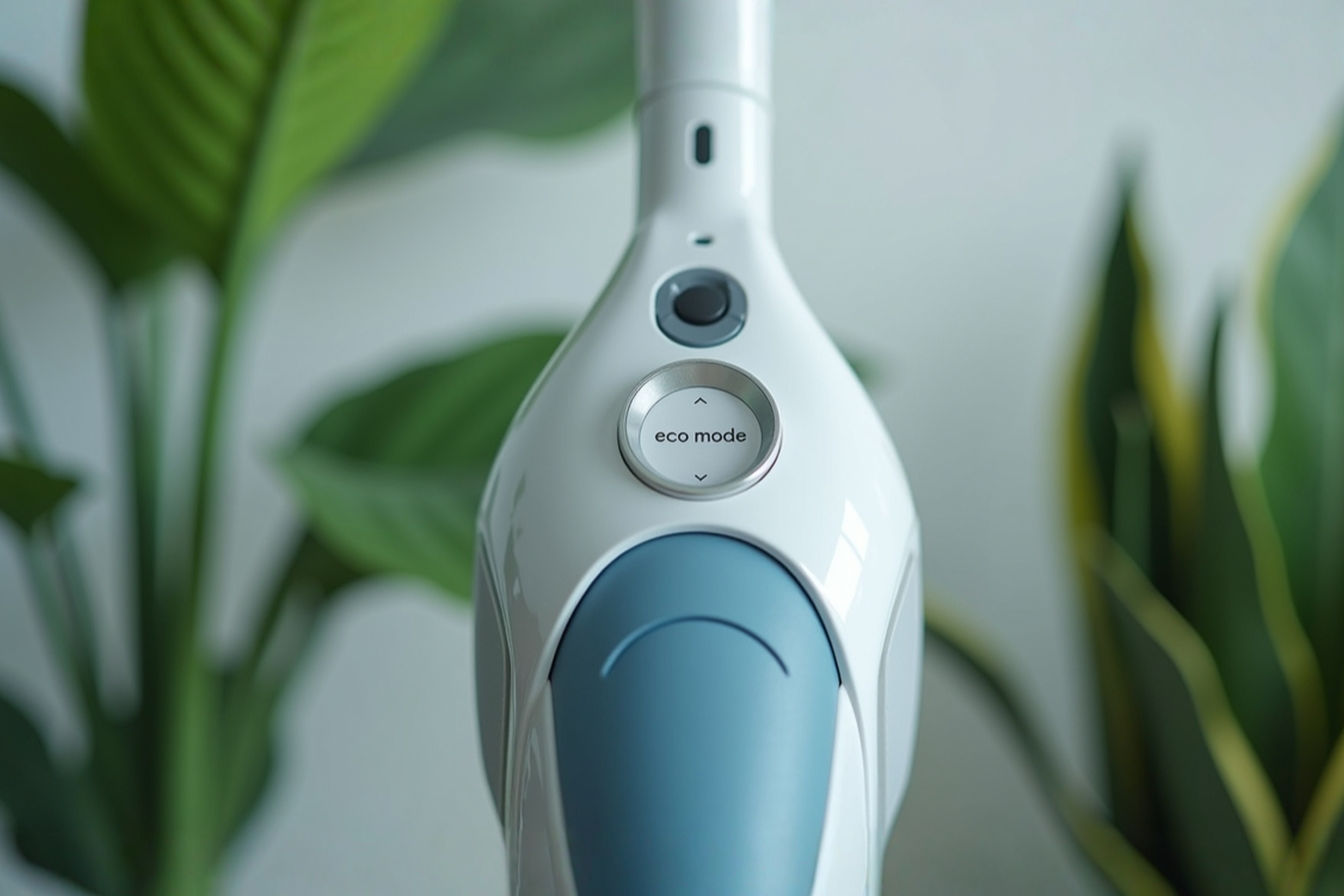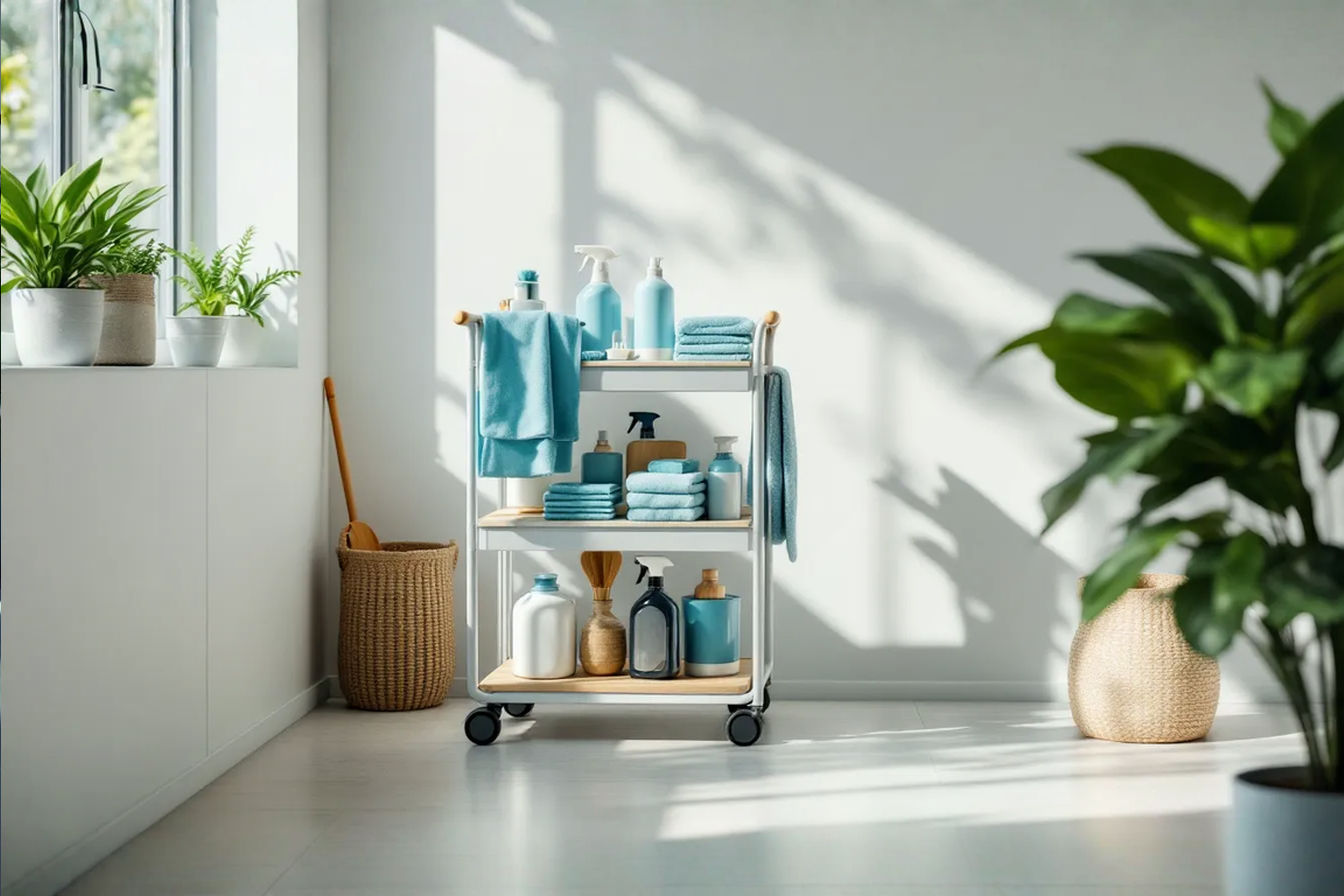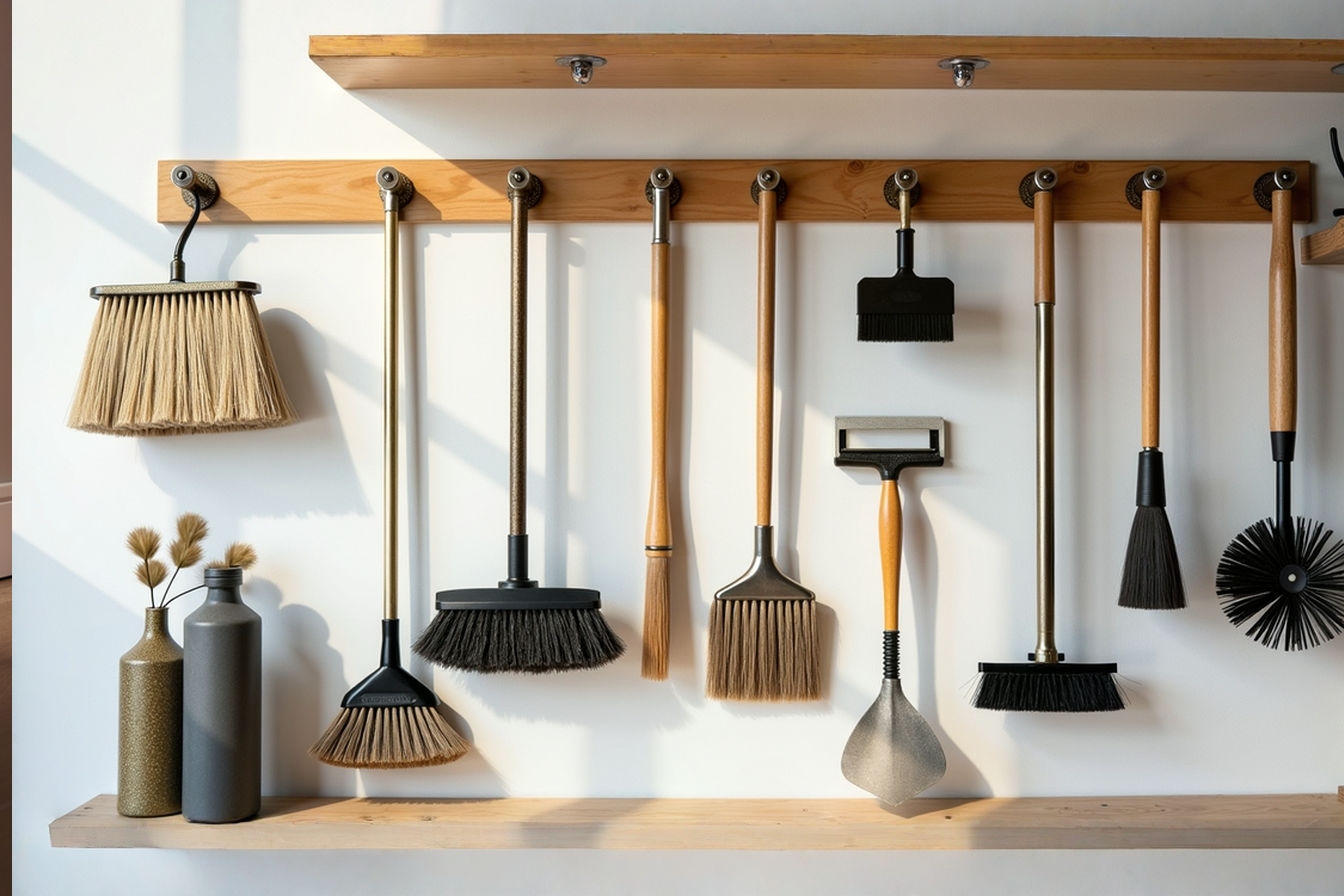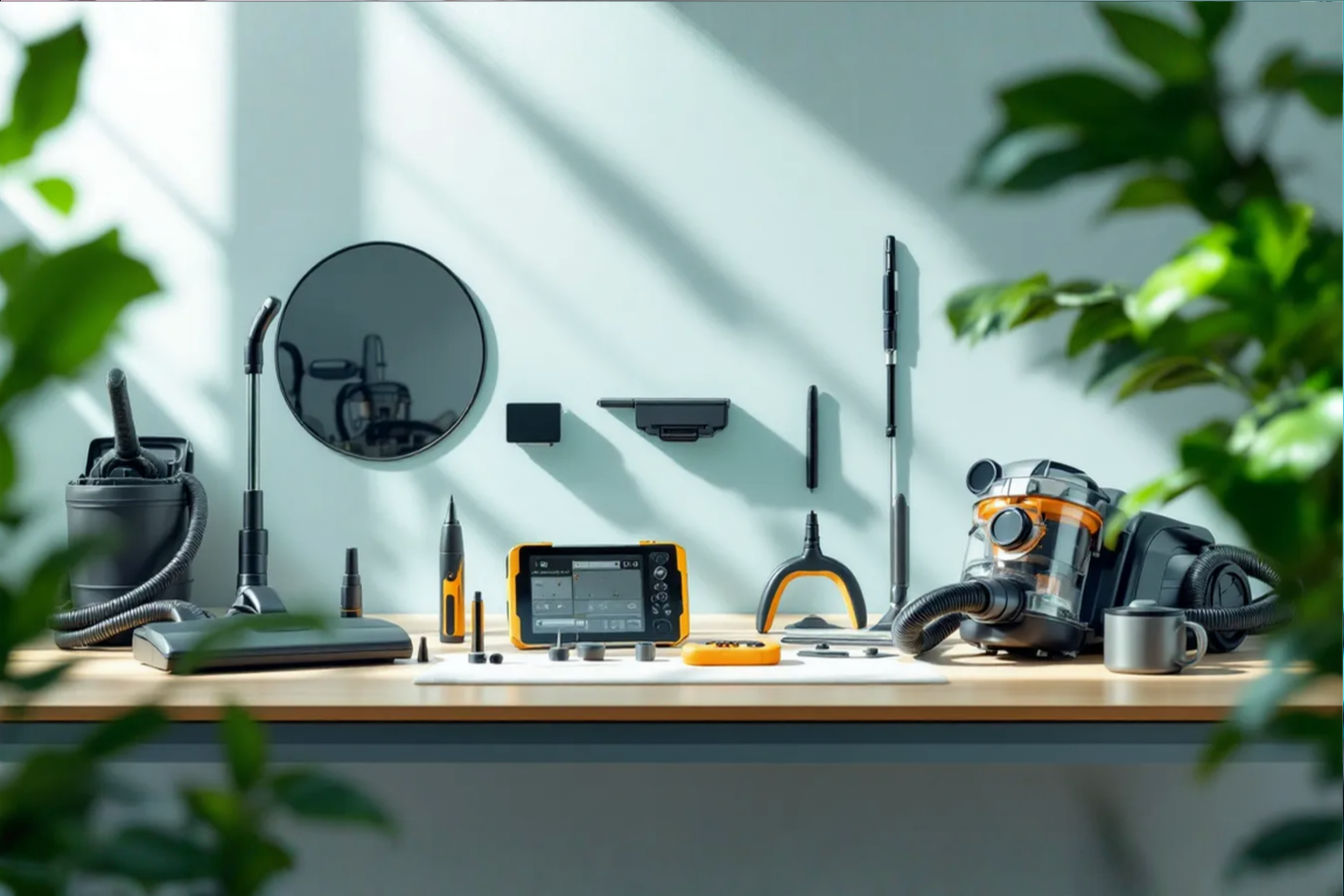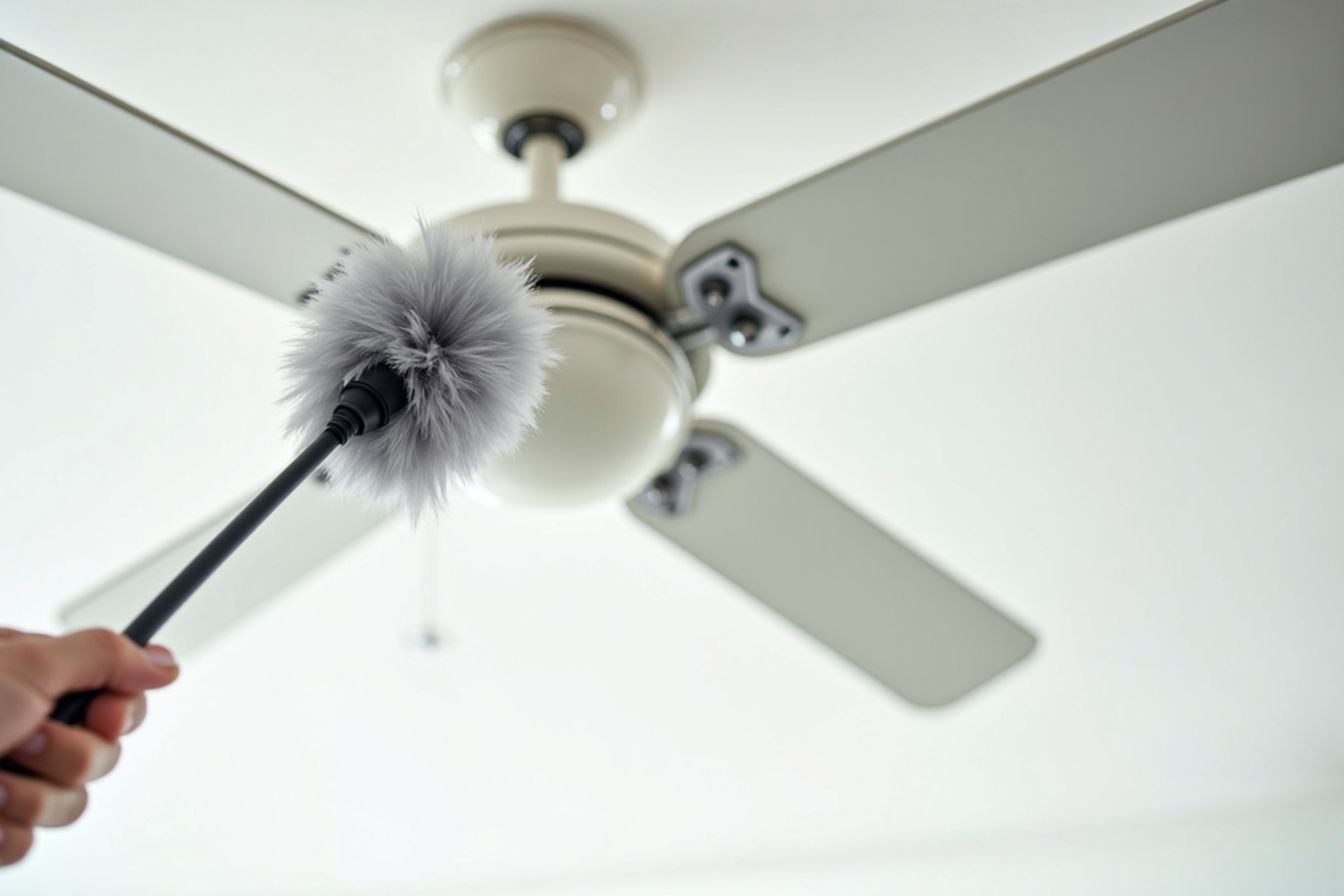Cleaning Schedule Automation: Programming Your Smart Home for Vacuum Routines
Transform your cleaning routine by automating your smart vacuum. This comprehensive guide covers everything from basic setup to advanced integration, helping you reclaim time while enjoying spotless floors.
This post may contain affiliate links. If you make a purchase through these links, we may earn a commission at no additional cost to you.
Imagine returning home after a long day to find your floors spotlessly clean—without having lifted a finger. This isn’t a luxury service or wishful thinking; it’s the reality that smart home vacuum automation brings to modern households. The intersection of robotics, artificial intelligence, and home automation has revolutionized how we maintain our living spaces, transforming cleaning from a time-consuming chore into a seamlessly automated background process.
For today’s busy homeowners, finding time to maintain a clean home presents a significant challenge. Between professional demands, family responsibilities, and personal pursuits, traditional cleaning routines often fall to the wayside. Cleaning schedule automation addresses this universal pain point by delegating vacuuming tasks to smart devices that work according to your preferences and needs.
This comprehensive guide explores how automated vacuum scheduling can transform your daily home maintenance routine. We’ll examine everything from basic setup procedures to advanced optimization techniques, helping you reclaim your time while enjoying a consistently clean home environment.
The Evolution of Home Cleaning: From Manual to Automated
Traditional Cleaning Challenges and Limitations
For decades, home cleaning followed predictable patterns: manual tools, significant time investment, and physical effort. Traditional vacuum cleaners, while effective, required direct human operation, storage space, and regular maintenance. This approach demanded dedicated cleaning sessions that consumed valuable weekend hours or created constant maintenance pressure throughout the week.
The limitations of conventional cleaning methods became increasingly apparent as household dynamics evolved. Two-income families, remote work arrangements, and busier lifestyles created a growing tension between time availability and cleaning needs. This discrepancy set the stage for a technological revolution in home maintenance.
The Rise of Robotic Vacuum Technology
The introduction of robotic vacuum cleaners marked the first significant leap toward automation. Early models offered basic functionalities—they could navigate open spaces and return to charging stations, but lacked precision and often required rescue from furniture entanglements. Despite these limitations, they demonstrated the tremendous potential for delegating repetitive cleaning tasks to machines.
Each subsequent generation of robotic vacuums brought significant improvements. Navigation systems evolved from random patterns to systematic coverage. Suction power increased to rival traditional vacuums. Battery life extended from minutes to hours. These incremental advances gradually transformed robotic vacuums from novelty gadgets into practical cleaning solutions for everyday households.
The Smart Home Revolution and Its Impact on Cleaning Routines
The broader smart home movement accelerated the evolution of automated cleaning systems. As households adopted connected technologies—smart speakers, lighting systems, security cameras—the infrastructure for sophisticated home automation became commonplace. This connectivity ecosystem provided the foundation for next-generation cleaning automation.
Robotic vacuums transformed from standalone devices into integrated components of comprehensive smart home systems. This integration enabled cross-device communication, conditional automations, and unprecedented convenience. Your vacuum could now coordinate with door sensors, calendar apps, and even personal location data to optimize cleaning schedules around your lifestyle.
Current State of Automated Cleaning Systems
Today’s automated vacuum systems represent a dramatic departure from their predecessors. Modern devices combine sophisticated mapping capabilities, powerful suction systems, and intelligent software to create truly autonomous cleaning solutions. They can differentiate between room types, adjust cleaning intensity based on surface materials, and navigate complex environments with remarkable precision.
The current generation of smart vacuums addresses historical limitations through technological innovation. Advanced obstacle detection prevents furniture damage. Self-emptying capabilities reduce maintenance frequency. Specialized sensors detect areas requiring extra attention. These features collectively transform automated cleaning from a partial solution to a comprehensive home maintenance system that adapts to your specific environment.
Key Benefits of Automating Your Vacuum Cleaning Schedule
Time Efficiency and Reclaiming Personal Hours
The average American spends approximately six hours weekly on household cleaning. Automated vacuum scheduling can reclaim a significant portion of this time by eliminating the need for manual floor cleaning. This benefit extends beyond the actual vacuuming time to include the mental burden of remembering cleaning tasks and coordinating them with other responsibilities.
The time efficiency of automated cleaning creates a ripple effect throughout your schedule. Those reclaimed hours translate to more quality time with family, additional capacity for personal projects, or simply reduced stress from a lightened to-do list. This benefit becomes particularly valuable for households with demanding professional schedules or families juggling multiple calendars.
Consistency in Cleaning Results and Home Maintenance
Human cleaning patterns naturally vary based on energy levels, available time, and competing priorities. Automated systems, by contrast, maintain perfect consistency in their cleaning routines. Your vacuum will clean with the same thoroughness on Monday morning as it does on Friday evening, regardless of your schedule fluctuations.
This consistency yields cumulative benefits for home maintenance. Regular cleaning prevents dirt accumulation that would otherwise require periodic deep cleaning sessions. It also extends the lifespan of flooring by preventing abrasive particle buildup that damages surfaces over time. The result is both improved cleanliness and reduced long-term maintenance requirements.
Customization Possibilities for Different Household Needs
Modern cleaning automation adapts to diverse household needs through customizable scheduling options. Homes with children might require daily kitchen cleaning but weekly bedroom attention. Pet owners might prioritize high-traffic areas for multiple daily cleaning sessions while scheduling comprehensive cleaning less frequently.
This customization extends to cleaning intensity as well. Many systems allow variable suction settings for different areas—maximum power for high-traffic zones and gentler cleaning for delicate surfaces. These preferences can be programmed directly into your cleaning schedule, ensuring each area receives appropriate treatment without requiring manual adjustments.
Reduced Physical Strain and Accessibility Advantages
Traditional vacuuming involves physical exertion that can pose challenges for individuals with mobility limitations, chronic pain conditions, or age-related restrictions. Automated systems eliminate this physical burden, making thorough home cleaning accessible regardless of physical capabilities.
This accessibility benefit extends beyond those with permanent physical limitations. During temporary situations—recovery from surgery, pregnancy, or injury—automated cleaning systems maintain home cleanliness without requiring physical strain. This adaptability ensures continuous home maintenance through life’s changing circumstances.
Energy and Resource Optimization
Despite intuitive assumptions, automated vacuum systems typically consume less energy than traditional vacuum cleaners. Their efficient motors, targeted cleaning patterns, and optimized run times result in lower electricity usage compared to conventional cleaning methods. This efficiency translates to both environmental benefits and reduced utility costs.
Resource optimization extends to time management as well. Automated systems can operate during ideal periods—while you’re at work, overnight in unoccupied areas, or during typical away times. This scheduling flexibility allows cleaning to occur during otherwise unproductive hours, maximizing your home’s operational efficiency.
Understanding Smart Vacuum Technology and Capabilities
Core Components of Modern Smart Vacuums
The foundation of automated vacuum scheduling rests on sophisticated hardware systems. At their core, smart vacuums combine mobility mechanisms (wheels, tracks, or rollers), suction systems, collection containers, and navigation hardware. These physical components provide the mechanical capabilities necessary for effective cleaning.
Beyond these basics, advanced models incorporate specialized brushes for different surface types, HEPA filtration systems for allergen control, and water tanks for mopping functionality. The combination of these components determines cleaning effectiveness across various environments—from hardwood floors to high-pile carpets to mixed-surface homes.
Navigation and Mapping Technologies Explained
Mapping technology represents the most significant advancement in recent vacuum automation. Early robotic vacuums relied on random navigation patterns and basic obstacle avoidance. Modern systems employ sophisticated mapping using LIDAR (Light Detection and Ranging), visual SLAM (Simultaneous Localization and Mapping), or camera-based systems to create detailed environmental models.
These mapping capabilities enable precise location awareness within your home. The vacuum knows exactly where it has cleaned, what areas remain, and how to navigate efficiently between zones. This spatial understanding allows for deliberate cleaning patterns rather than random coverage, significantly improving cleaning efficiency and battery utilization.
Sensor Systems and Their Role in Automation
Complementing mapping technologies, sensor arrays provide real-time environmental data that influences cleaning behavior. Cliff sensors prevent falls on stairs or ledges. Obstacle detection systems identify and navigate around furniture. Dirt sensors recognize areas requiring additional attention and adjust suction or cleaning patterns accordingly.
These sensor systems collectively create adaptive cleaning behaviors that respond to your home’s specific conditions. Rather than following rigid programming, modern vacuums make thousands of micro-decisions during each cleaning session, optimizing their approach based on encountered conditions and programmed preferences.
Connectivity Features Enabling Smart Scheduling
Wi-Fi connectivity forms the backbone of advanced scheduling capabilities by enabling communication between your vacuum, mobile applications, and broader smart home systems. This connectivity allows schedule programming, real-time monitoring, and remote operation from anywhere with internet access.
Beyond basic connectivity, modern systems support API integration with other smart platforms. This interoperability enables complex automation scenarios involving multiple devices. Your vacuum might automatically begin cleaning when your phone’s GPS shows you’ve left for work, pause when a security camera detects package delivery, and resume once the delivery person departs.
Battery Technology and Runtime Considerations
Battery advancements have dramatically extended operational capabilities for automated vacuum systems. Early models required frequent recharging and often failed to complete larger homes on a single charge. Current lithium-ion battery implementations provide runtimes of 120+ minutes, sufficient for most residential environments.
Intelligent power management systems further extend effective coverage by monitoring battery levels and implementing strategic recharging. When cleaning larger spaces, vacuums automatically return to charging stations when battery levels drop, recharge to the necessary level, and resume exactly where they left off. This charge-and-continue capability enables complete cleaning of spaces that exceed single-charge capacity.
Setting Up Your First Automated Cleaning Schedule
Initial Setup Requirements for Smart Vacuum Automation
Before creating your first automated schedule, several foundational elements must be established. Your smart vacuum requires a stable Wi-Fi connection within range of its operational area. The associated mobile application must be installed on a compatible device, and initial device pairing completed according to manufacturer instructions.
Most systems require a preliminary mapping run before schedule creation. This initial cleaning session allows the vacuum to explore your home, document its layout, and establish spatial reference points. For optimal mapping, remove temporary obstacles, secure loose cables, and ensure doors are positioned as they typically would be during regular cleaning sessions.
Evaluating Your Home’s Layout for Optimal Scheduling
Consider your home’s specific characteristics when planning automation schedules. Multi-level homes require different approaches than single-floor apartments. Open concept designs present fewer navigation challenges than compartmentalized layouts. Homes with varied flooring types might benefit from zone-specific cleaning frequencies.
Traffic patterns significantly influence optimal scheduling. Areas with frequent foot traffic—entryways, kitchens, and main hallways—generally require more frequent cleaning than less-used spaces. Identify these high-traffic zones and consider scheduling them for more frequent attention than lower-traffic areas like guest rooms or formal dining spaces.
Basic Schedule Creation: Frequency, Timing, and Duration
Start with a foundational schedule that balances cleanliness goals with practical constraints. For many households, a complete home cleaning 2-3 times weekly provides sufficient maintenance. Complement this comprehensive approach with targeted daily cleaning of high-traffic areas for optimal results.
Timing considerations vary based on household routines. Scheduling cleaning during typical away hours—work days, school hours, or regular social engagements—minimizes disruption. If you work from home or have irregular schedules, consider cleaning during predictable out-of-home activities like gym sessions or shopping trips.
Duration settings depend on both home size and cleaning thoroughness preferences. Most applications offer adjustable cleaning intensity options that trade thoroughness for speed. For regular maintenance cleaning, standard modes typically provide sufficient cleaning while conserving battery life. Reserve maximum intensity settings for periodic deep cleaning sessions or special circumstances.
Mobile App Configurations and User Interfaces
Smart vacuum apps vary in complexity and feature sets, but most share common scheduling interfaces. Typical options include day selection (which days to clean), time selection (when to begin cleaning), and mode selection (cleaning intensity). These primary controls allow basic schedule creation for consistent weekly routines.
Look beyond these basics to discover advanced options that enhance customization. Room selection features enable targeted cleaning of specific areas. Do Not Disturb settings prevent operation during specified hours regardless of scheduled times. Notification preferences control alerts for cleaning starts, completions, and maintenance needs.
Testing and Refining Your Initial Schedule
After establishing your initial schedule, observe several complete cycles before making refinements. Monitor cleaning effectiveness, battery utilization, and completion times. Watch for areas that might need additional attention or zones where obstacles consistently challenge navigation.
Use these observations to refine your approach. Adjust frequency based on observed dirt accumulation. Modify cleaning times if the current schedule creates unexpected conflicts. Consider adding supplemental targeted cleaning for problem areas while maintaining the core schedule for general maintenance.
Advanced Scheduling Techniques for Optimal Results
Zone-Based Cleaning Schedules for Targeted Areas
Modern mapping capabilities enable sophisticated zone-based scheduling that treats different areas with varying frequencies and intensities. This approach allows precise resource allocation based on actual cleaning needs rather than applying uniform treatment throughout your home.
Create customized zones corresponding to functional areas—living room, kitchen, entryway, bedrooms—and assign appropriate cleaning frequencies to each. High-traffic or high-mess areas like kitchens and entryways might benefit from daily attention, while guest rooms or formal areas might require only weekly or bi-weekly cleaning.
Zone-based scheduling optimizes both cleaning effectiveness and system efficiency. By focusing cleaning resources where they provide maximum benefit, you achieve better results while minimizing energy consumption and device wear. This targeted approach often reduces total cleaning time while improving overall cleanliness levels.
Creating No-Go Zones and Virtual Boundaries
Complementing zone-based cleaning, boundary definition features allow you to exclude specific areas from automated cleaning. This capability protects sensitive equipment, prevents access to problem areas, and solves common automation challenges like cord tangles or rug tassels.
Most systems offer multiple boundary types. Keep-out zones create permanent restrictions for areas that should never be cleaned automatically. Temporary boundaries can be activated situationally—for instance, around a temporarily placed plant or during a short-term home project. Virtual walls simulate physical barriers, creating straight-line boundaries across open spaces.
Effective boundary use requires strategic thinking about both permanent and temporary home features. Permanent boundaries work well around fixed features like pet feeding stations or entertainment centers with exposed cables. Temporary boundaries provide flexibility for changing household dynamics without requiring complete schedule reconfiguration.
Multi-Floor Mapping and Scheduling Strategies
Homes with multiple levels present unique challenges for automated cleaning. Most advanced systems support multi-floor mapping, storing separate maps for each level and recognizing their current location when placed on different floors. This capability enables comprehensive cleaning across your entire home.
Develop level-specific scheduling strategies based on usage patterns and practical considerations. Main living floors typically require more frequent cleaning than upper-level bedrooms or lower-level recreation spaces. Consider logistical factors like vacuum storage location and your willingness to relocate the device between cleaning sessions.
For optimal multi-floor management, establish a predictable rotation schedule. Some households prefer alternating levels on different days, while others dedicate specific days to complete home cleaning. Your approach should balance cleanliness requirements with practical convenience based on your specific living patterns.
Seasonal and Special Event Scheduling Adjustments
Static cleaning schedules rarely accommodate the dynamic nature of home life. Seasonal changes—summer sand tracking, fall leaf debris, winter salt residue—create variable cleaning requirements throughout the year. Special events like holidays, house guests, or home projects similarly disrupt normal patterns.
Develop seasonal scheduling adjustments that anticipate these predictable variations. Increase cleaning frequency during high-pollen seasons if allergies affect your household. Schedule additional sessions during shedding seasons for pet owners. Reduce frequency in rarely used vacation homes during off-seasons while increasing it during occupancy periods.
For special events, use temporary schedule modifications rather than permanent changes. Increase cleaning frequency before guest arrivals, schedule additional sessions during extended visits, and return to normal patterns afterward. This approach maintains long-term consistency while accommodating short-term variations.
Conditional Automation Based on Household Activities
The most sophisticated scheduling approaches integrate with broader home systems to create conditional automations based on actual household activities. These integrations connect cleaning schedules to occupancy patterns, calendar events, or other smart home triggers rather than relying solely on time-based scheduling.
Common conditional triggers include home departure (cleaning begins when everyone leaves), weather conditions (extra cleaning during high-pollen days), or specific events (cleaning after scheduled playdates or dinner parties). These conditional automations adapt to your actual lifestyle rather than imposing rigid schedules that might not align with changing routines.
Implementing conditional automation typically requires integration between your vacuum system and other smart home components. While setup complexity exceeds basic scheduling, the resulting flexibility creates a truly adaptive cleaning system that accommodates your life rather than requiring adaptation to fixed cleaning routines.
Integrating Your Vacuum into the Smart Home Ecosystem
Compatibility with Major Smart Home Platforms
Most premium smart vacuums support integration with dominant smart home platforms—Apple HomeKit, Google Home, Amazon Alexa, and Samsung SmartThings. This compatibility enables centralized control through your preferred ecosystem rather than requiring separate management through manufacturer-specific applications.
Platform integration levels vary significantly between vacuum brands and models. Basic integration might allow simple voice commands or include the vacuum in platform-based routines. Advanced integration enables sophisticated automation rules, detailed status reporting, and comprehensive control through your platform’s interface.
When selecting a smart vacuum for automation purposes, consider both current compatibility and the manufacturer’s history of platform support. Some brands prioritize broad ecosystem compatibility and regular updates to maintain connectivity as platforms evolve. Others focus primarily on their proprietary apps with limited third-party integration.
Voice Assistant Integration and Commands
Voice control adds significant convenience to vacuum automation by enabling schedule adjustments without requiring application access. Common voice capabilities include starting/stopping cleaning sessions, directing the vacuum to specific rooms, and requesting status updates about cleaning progress or maintenance needs.
Effective voice integration depends on consistent command terminology and logical instruction structure. Most systems support natural language variations—”clean the kitchen” might work interchangeably with “vacuum the kitchen” or “start cleaning in the kitchen.” Explore your specific system’s command options to discover available voice controls.
Beyond simple commands, voice systems can query cleaning status and history. Questions like “When did the vacuum last clean the living room?” or “Is the vacuum currently cleaning?” provide quick information access without requiring application engagement. These informational commands complement direct control functions to create comprehensive voice management.
Creating Automation Routines with Other Smart Devices
The true power of smart home integration emerges when your vacuum participates in multi-device automation routines. These coordinated sequences combine actions from various smart devices based on triggers, conditions, and timing to create sophisticated home management systems that extend well beyond simple cleaning.
Common automation combinations include:
- Departure routines that adjust thermostats, secure doors, turn off lights, and begin vacuum cleaning when you leave home
- Morning preparation sequences that raise blinds, start coffee makers, provide weather updates, and clean kitchen areas after breakfast preparation
- Evening shutdown procedures that verify door locks, activate security systems, turn off entertainment devices, and perform final cleaning sweeps
Creating these routines typically involves your smart home platform’s automation interface rather than the vacuum’s dedicated application. The vacuum becomes a participant in broader automations rather than the central controller, allowing coordination across your entire smart home ecosystem.
Remote Monitoring and Control Capabilities
Remote access transforms vacuum automation from a background process to an actively manageable system. Modern applications provide real-time status updates, cleaning maps, and remote control capabilities from anywhere with internet connectivity. This visibility ensures cleaning proceeds as expected even when you’re away from home.
Common remote monitoring features include cleaning progress tracking, battery status updates, and maintenance alerts. These capabilities provide peace of mind during extended absences while allowing prompt response to potential issues. If cleaning stops unexpectedly, you can investigate remotely rather than discovering problems upon return.
Remote control functions extend beyond monitoring to active management. You can start unscheduled cleaning sessions when unexpected visitors announce their arrival. You can direct the vacuum to specific rooms that require immediate attention. You can modify schedules to accommodate changing plans without requiring physical presence.
Security and Privacy Considerations
Smart vacuum systems collect significant data about your home and habits. Floor plans, cleaning schedules, and usage patterns provide insights into your lifestyle that require appropriate security protection. Before implementing automation, understand what data your system collects, how it’s stored, and who might have access.
Minimize security vulnerabilities by following essential smart device practices. Use strong, unique passwords for associated accounts. Enable two-factor authentication when available. Keep firmware and applications updated to address security vulnerabilities. Consider network segregation for IoT devices if your router supports VLAN capabilities or guest networks.
Privacy considerations extend beyond security to data usage policies. Review manufacturer privacy statements to understand how your information might be used for product improvement, marketing, or third-party sharing. Many systems allow customization of data collection settings, enabling you to balance functionality with privacy preferences based on your personal comfort level.
Optimizing Performance and Maintenance Through Automation
Battery Life Optimization Strategies
Battery performance significantly impacts cleaning effectiveness over time. Intelligent scheduling can maximize battery lifespan while ensuring consistent cleaning results. Schedule complete discharge cycles occasionally rather than maintaining partial charges continuously. This practice helps prevent battery memory effects that gradually reduce capacity.
Optimize runtime efficiency by scheduling cleaning during optimal conditions. Battery performance diminishes in extreme temperatures, so scheduling during moderate temperature periods can extend operational duration. Similarly, breaking extensive cleaning tasks into multiple sessions with recharge intervals often proves more efficient than attempting complete cleaning on a single charge.
Advanced power management features automatically adjust suction levels based on surface types and detected dirt. These adaptive systems provide maximum cleaning power where needed while conserving energy on already-clean surfaces. Enable these features when available to maximize cleaning efficiency without unnecessary battery drain.
Automated Maintenance Reminders and Schedules
Physical maintenance remains necessary even with fully automated cleaning systems. Brush cleaning, filter replacement, sensor wiping, and bin emptying ensure optimal performance over time. Modern systems track component usage and automatically generate maintenance reminders based on actual operation rather than arbitrary timeframes.
Create a comprehensive maintenance schedule that incorporates these automated reminders. Categorize tasks by frequency—daily (bin emptying), weekly (brush cleaning), monthly (sensor wiping), and quarterly (filter replacement)—and integrate them with your calendar or task management system. This proactive approach prevents performance degradation due to neglected maintenance.
For households with multiple users, consider shared maintenance responsibilities through application account sharing. Most platforms support multiple user accounts with equal access to maintenance notifications. This capability ensures maintenance alerts reach all household members rather than remaining isolated on a single user’s device.
Filter and Component Replacement Automation
Beyond reminders, many systems now support automated component ordering through application integration with e-commerce platforms. When consumable components—filters, brushes, or bags—approach end-of-life, the system can automatically place replacement orders to arrive before performance degradation occurs.
Implementation typically requires linking your vacuum application with compatible shopping accounts and enabling automatic reordering. While this convenience carries premium pricing compared to manual replacement purchasing, it eliminates maintenance gaps that might otherwise occur when components fail between manual ordering and delivery.
For cost-conscious households, semi-automated approaches provide middle-ground options. Enable replacement notifications but disable automatic ordering. When alerts appear, manually review replacement options across multiple vendors rather than accepting automatic reordering. This approach maintains awareness of maintenance needs while allowing price comparison before purchase.
Performance Tracking and Efficiency Analysis
Modern vacuum systems generate extensive performance data during operation. Cleaning coverage maps, duration metrics, error frequencies, and battery consumption patterns provide insights into system efficiency. Many applications include analysis tools that identify trends, anomalies, and optimization opportunities within this operational data.
Regular review of these performance metrics enables continuous optimization of your cleaning automation strategy. Identify consistently problematic areas that might benefit from environmental modifications—perhaps relocated furniture for better navigation or cable management solutions for entanglement-prone zones. Recognize patterns in cleaning duration that might indicate maintenance needs before performance visibly degrades.
The most sophisticated systems incorporate machine learning to analyze performance patterns and suggest optimization strategies. These recommendations might include schedule modifications, cleaning intensity adjustments, or maintenance interventions based on detected anomalies. Consider these suggestions while maintaining critical evaluation of their relevance to your specific household needs.
Self-Emptying Systems and Dock Management
Self-emptying capabilities represent the newest frontier in cleaning automation by addressing the most frequent maintenance requirement—dust bin emptying. These systems automatically transfer collected debris from the vacuum to a larger container in the charging dock, extending independent operation from days to weeks between human interventions.
Optimal placement of self-emptying docks requires careful consideration of multiple factors. The emptying process generates moderate noise, suggesting locations away from sleeping or working areas. The dock requires adequate clearance for proper vacuum alignment during docking procedures. Power outlet placement constrains positioning options unless custom wiring solutions are implemented.
While self-emptying systems significantly reduce maintenance frequency, they don’t eliminate it entirely. The dock’s collection container eventually requires emptying, and other maintenance tasks remain unchanged. However, the reduced intervention frequency makes these systems particularly valuable for larger homes, busy households, or users with physical limitations that make frequent maintenance challenging.
Troubleshooting Common Automation Issues
Connectivity and Wi-Fi Reliability Problems
Wi-Fi connectivity forms the foundation of reliable vacuum automation. Intermittent connections cause missed cleaning schedules, incomplete sessions, and synchronization failures. Common connectivity challenges include weak signal areas, network congestion, and router compatibility issues that prevent consistent communication.
Address signal strength problems through strategic router placement or mesh network systems that extend coverage throughout your home. Position network components to minimize physical barriers like concrete walls or metal structures that block signals. Consider dedicated IoT networks if your router supports multiple SSIDs to reduce congestion from competing devices.
Persistent connectivity problems despite adequate signal strength often indicate router compatibility issues. Some vacuum systems struggle with specific security protocols, dual-band implementations, or router firmware versions. Consult manufacturer support resources for known compatibility limitations and recommended router configurations to resolve these specialized challenges.
Schedule Execution Failures and Workarounds
Even with stable connectivity, scheduled cleaning occasionally fails due to various environmental factors. Physical obstacles preventing dock departure, unexpected floor hazards (spilled liquids, new cables), or doors closed between scheduled areas can prevent proper execution despite system functionality.
Implement verification systems to confirm schedule execution and alert you to failures. Most applications provide cleaning history logs that document completed, attempted, and failed sessions. Configure notification settings to alert you when scheduled cleaning doesn’t occur, allowing prompt investigation rather than discovering missed cleaning days later.
When schedule execution consistently fails in specific circumstances, consider conditional scheduling approaches rather than time-based automation. Trigger cleaning based on reliable conditions—home occupancy status, time since last successful cleaning, or manual activation—rather than rigid time schedules that might not accommodate your household’s natural variability.
Navigation and Mapping Errors
Mapping systems occasionally encounter confusion that impacts cleaning effectiveness. Significant furniture rearrangement, lighting condition changes, or temporary obstacles can challenge spatial recognition systems. These challenges typically manifest as missed areas, redundant cleaning of the same space, or navigation failures in previously successful zones.
Address persistent mapping problems by initiating remapping procedures when your home layout changes significantly. Most systems include options to update existing maps or create entirely new references as needed. While this process requires temporary return to manual management, it establishes a fresh spatial foundation for future automation.
For temporary changes that don’t warrant complete remapping, use containment features to simplify the cleaning environment. Virtual boundaries can temporarily exclude areas undergoing rearrangement or containing unusual obstacles. This approach maintains automation throughout stable areas while preventing navigation confusion in modified zones.
Battery and Charging Complications
Battery-related issues frequently disrupt automated cleaning schedules. Failed charging attempts due to dock misalignment, reduced capacity from battery aging, or temperature-related performance limitations can prevent completion of scheduled tasks despite otherwise functional systems.
Ensure proper charging dock placement to facilitate reliable contact. Position the dock against walls on non-slip surfaces with adequate approach clearance. Clean charging contacts regularly to prevent connection failures due to dust accumulation. Consider secondary docking stations in multi-level homes rather than relocating a single dock between floors.
Address diminishing battery performance proactively as your system ages. Most vacuum batteries maintain optimal performance for 2-3 years before capacity noticeably decreases. Monitor cleaning duration trends to identify gradual reduction in operating time between charges. Research battery replacement options—either manufacturer service or DIY replacement kits—before capacity diminishes to disruptive levels.
Software Update Issues and Resolutions
Software updates occasionally introduce compatibility issues or feature changes that disrupt established automation routines. While updates generally improve functionality and security, their timing and potential for temporary disruption requires management within your broader cleaning strategy.
Control update timing to prevent disruption during critical periods. Most applications allow postponing updates rather than applying them immediately upon release. Schedule updates during low-priority periods when temporary system unavailability won’t impact household cleanliness—perhaps before upcoming travel rather than immediately before hosting visitors.
After significant updates, verify proper functioning of all automation components before relying on them exclusively. Run test cleaning cycles to confirm navigation accuracy, schedule execution, and integration with other smart home components. This verification prevents unexpected cleaning gaps due to update-related behavioral changes or compatibility issues.
Future Trends in Cleaning Schedule Automation
AI-Driven Predictive Cleaning Schedules
The next generation of cleaning automation will likely transcend rigid scheduling in favor of predictive systems that learn household patterns and anticipate cleaning needs. These AI-driven approaches will analyze historical data alongside environmental sensors to determine optimal cleaning timing based on actual conditions rather than predetermined schedules.
Imagine systems that recognize when the kitchen experiences heavy use and automatically schedule targeted cleaning afterward. Or vacuums that detect higher-than-normal pollen counts and initiate additional cleaning cycles during allergy seasons. These contextually aware systems will provide truly adaptive cleaning that responds to your household’s actual needs rather than approximating them through fixed schedules.
Early implementations of these capabilities have begun appearing in premium models through “dirt detection” systems that extend cleaning in areas showing higher debris concentration. Future iterations will likely expand this situational awareness to incorporate broader environmental factors, calendar integration, and behavioral pattern recognition for comprehensive cleaning intelligence.
Advanced Sensor Integration and Environmental Awareness
Sensor technology continues advancing rapidly, with implications for cleaning automation effectiveness. Future systems will likely incorporate air quality monitoring, allergen detection, and surface analysis capabilities alongside traditional navigation sensors. These additional data streams will enable more sophisticated cleaning strategies tailored to specific environmental conditions.
Specialized sensors might trigger different cleaning approaches based on detected needs—increasing suction for pollen reduction during spring months, prioritizing pet areas after detecting dander accumulation, or focusing on entryways during wet weather periods when mud tracking increases. This environmental awareness transforms cleaning from a standardized process to a responsive service addressing actual conditions.
Beyond internal sensors, integration with external data sources will further enhance contextual awareness. Weather forecasts might influence cleaning schedules during predicted high-pollen days. Smart door locks could trigger entryway cleaning after detecting multiple entries during muddy conditions. These external data connections create cleaning systems that respond to both internal and external factors affecting your home environment.
Self-Maintaining Vacuum Systems
Current automation primarily addresses the cleaning process while leaving maintenance requirements to human intervention. Future systems will likely extend automation to maintenance functions—brush self-cleaning mechanisms, internal component monitoring with automated service requests, and predictive part replacement before failure occurs.
Early implementations already include self-emptying capabilities, but comprehensive self-maintenance remains developmental. Research directions suggest possibilities for brush self-cleaning through specialized dock mechanisms, automatic sensor cleaning procedures, and internal diagnostics that detect performance anomalies before they become problematic. These capabilities would further reduce human intervention requirements while maintaining optimal performance.
The ultimate evolution might integrate maintenance with service ecosystems that combine self-diagnosis with professional intervention when necessary. Detected issues beyond self-maintenance capabilities could automatically schedule service appointments, order replacement parts, or provide specific troubleshooting guidance based on detected conditions rather than generic support resources.
Integration with Smart Home Environmental Controls
The convergence of cleaning systems with broader environmental management presents particularly promising automation opportunities. Integration between HVAC systems, air purifiers, and vacuum automation could create comprehensive environmental quality management rather than treating these functions as separate systems.
Coordinated approaches might include running air purifiers during vacuum operation to capture airborne particles stirred up during cleaning. Or automatically adjusting vacuum schedules based on detected HVAC filter conditions—increasing cleaning frequency when filters show higher particulate accumulation. These integrations address indoor air quality holistically rather than through isolated device functions.
For households with specific health considerations—allergy sufferers, asthma patients, or immunocompromised individuals—these integrated approaches could transform home environments through proactive management rather than reactive intervention. Automatic environmental quality optimization would maintain consistent conditions by coordinating all available systems rather than requiring manual orchestration of multiple devices.
Conclusion
Cleaning schedule automation represents a fundamental shift in home maintenance philosophy—from manual intervention to intelligent delegation. This transformation delivers tangible benefits including time savings, cleaning consistency, and reduced physical burden that collectively enhance quality of life beyond mere cleanliness.
The journey toward optimal automation typically progresses through distinct phases. Begin with basic scheduling that establishes consistent cleaning patterns. Advance to zone-based approaches that target specific areas based on actual needs. Explore integration possibilities with your broader smart home ecosystem. Finally, implement continuous optimization based on performance data and emerging capabilities.
As automated cleaning technology continues evolving, the balance between human direction and system autonomy will shift increasingly toward self-managing systems. Future implementations will likely reduce configuration requirements while improving adaptability to changing conditions. However, the foundational goal remains consistent—creating clean, comfortable living environments that require minimal human intervention.
Whether you’re taking your first steps into cleaning automation or refining an established system, remember that technology serves your specific needs rather than imposing predetermined solutions. The most successful implementations balance technological capabilities with your household’s unique patterns, preferences, and priorities to create truly personalized automation that enhances your living experience.

